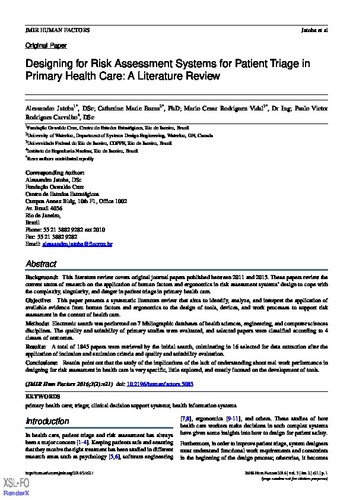| dc.contributor.author | Jatobá, Alessandro | |
| dc.contributor.author | Burns, Catherine Marie | |
| dc.contributor.author | Vidal, Mario Cesar Rodriguez | |
| dc.contributor.author | Carvalho, Paulo Victor Rodrigues | |
| dc.date.accessioned | 2020-05-26 20:23:02 (GMT) | |
| dc.date.available | 2020-05-26 20:23:02 (GMT) | |
| dc.date.issued | 2016-08-15 | |
| dc.identifier.uri | https://doi.org/10.2196/humanfactors.5083 | |
| dc.identifier.uri | http://hdl.handle.net/10012/15921 | |
| dc.description | This is an open-access article distributed under the terms of the Creative Commons Attribution License (http://creativecommons.org/licenses/by/2.0/), which permits unrestricted use, distribution, and reproduction in any medium, provided the original work, first published in JMIR Human Factors, is properly cited. The complete bibliographic information, a link to the original publication on http://humanfactors.jmir.org, as well as this copyright and license information must be included. | en |
| dc.description.abstract | Background: This literature review covers original journal papers published between 2011 and 2015. These papers review the current status of research on the application of human factors and ergonomics in risk assessment systems’ design to cope with the complexity, singularity, and danger in patient triage in primary health care.
Objective: This paper presents a systematic literature review that aims to identify, analyze, and interpret the application of available evidence from human factors and ergonomics to the design of tools, devices, and work processes to support risk assessment in the context of health care.
Methods: Electronic search was performed on 7 bibliographic databases of health sciences, engineering, and computer sciences disciplines. The quality and suitability of primary studies were evaluated, and selected papers were classified according to 4 classes of outcomes.
Results: A total of 1845 papers were retrieved by the initial search, culminating in 16 selected for data extraction after the application of inclusion and exclusion criteria and quality and suitability evaluation.
Conclusions: Results point out that the study of the implications of the lack of understanding about real work performance in designing for risk assessment in health care is very specific, little explored, and mostly focused on the development of tools. | en |
| dc.description.sponsorship | This study was partially funded by the Science Without Borders Program/Brazilian National Council for Scientific and Technological Development. | en |
| dc.language.iso | en | en |
| dc.publisher | MDPI | en |
| dc.rights | Attribution 4.0 International | * |
| dc.rights.uri | http://creativecommons.org/licenses/by/4.0/ | * |
| dc.subject | primary health care | en |
| dc.subject | triage | en |
| dc.subject | clinical decision support systems | en |
| dc.subject | health information systems | en |
| dc.title | Designing for Risk Assessment Systems for Patient Triage in Primary Health Care: A Literature Review | en |
| dc.type | Article | en |
| dcterms.bibliographicCitation | Jatoba A, Burns CM, Vidal MCR, Carvalho PVR Designing for Risk Assessment Systems for Patient Triage in Primary Health Care: A Literature Review JMIR Hum Factors 2016;3(2):e21 DOI: 10.2196/humanfactors.5083 | en |
| uws.contributor.affiliation1 | Faculty of Engineering | en |
| uws.contributor.affiliation2 | Systems Design Engineering | en |
| uws.typeOfResource | Text | en |
| uws.peerReviewStatus | Reviewed | en |
| uws.scholarLevel | Faculty | en |
| dc.identifier.pmcid | 5004057 | |


